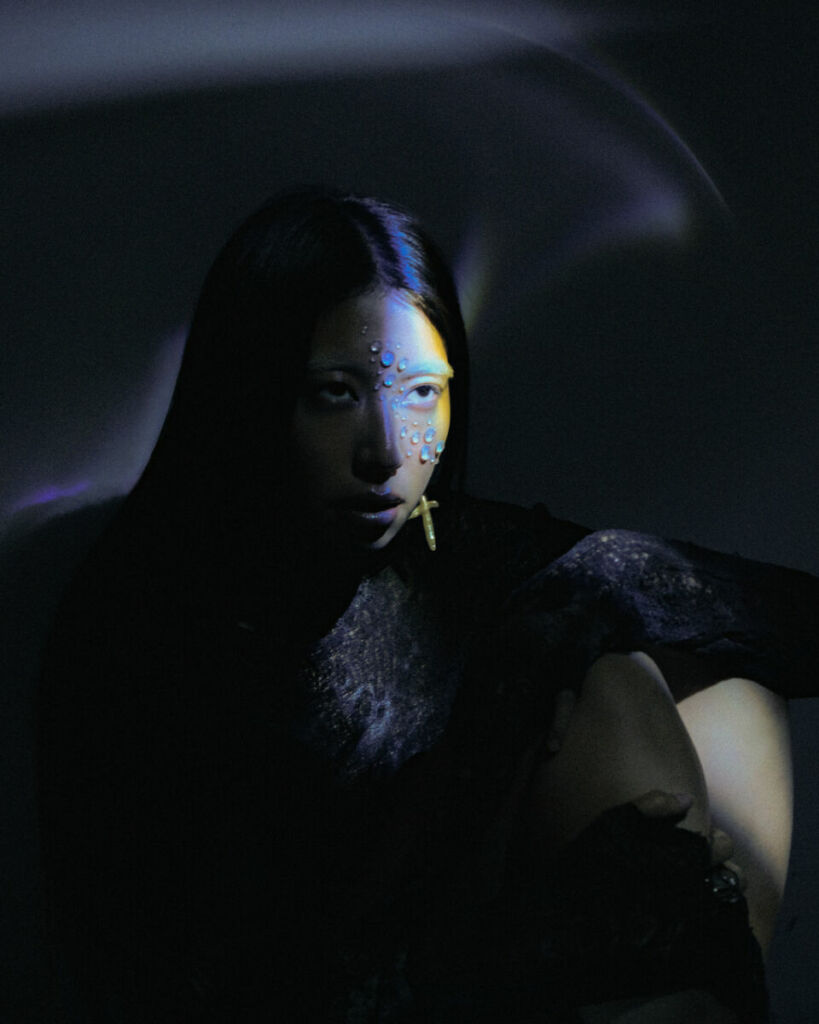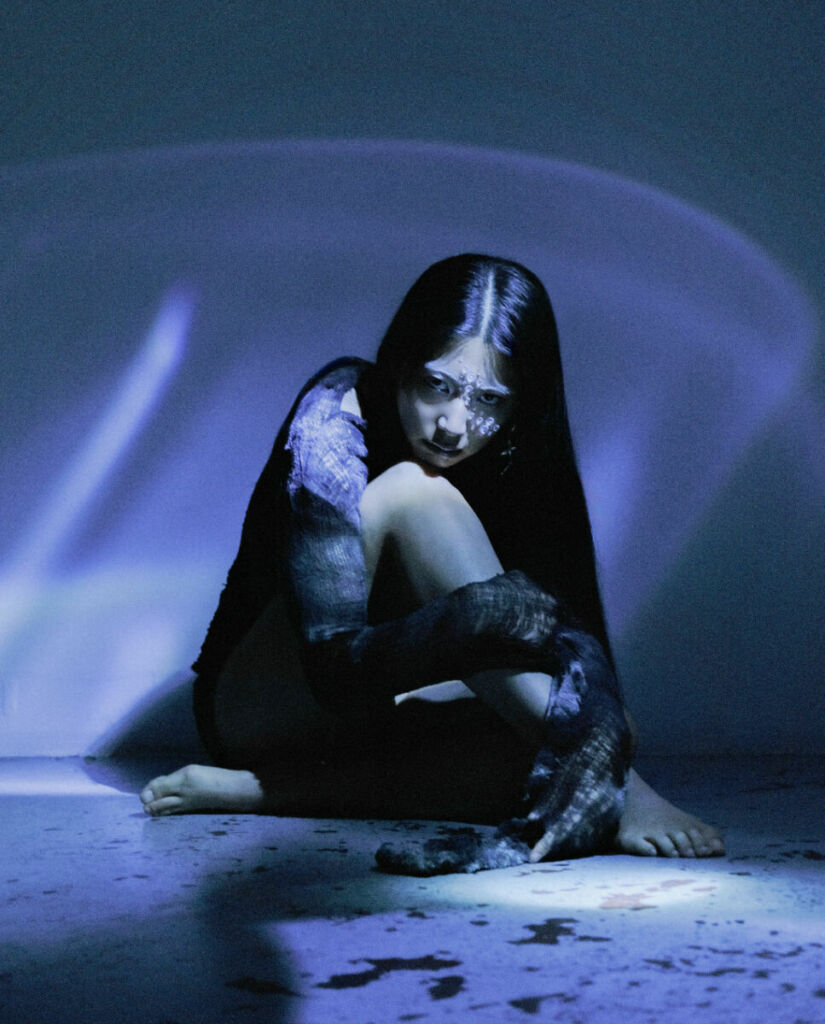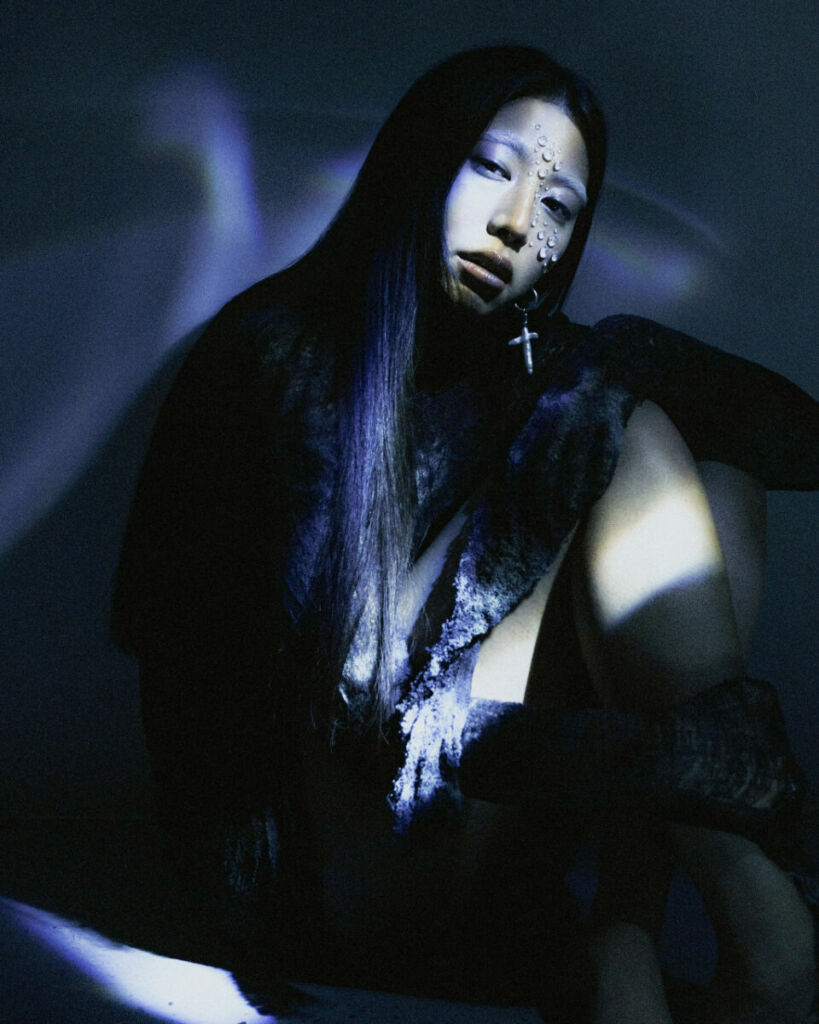Interview by Alifiyah Imani

Japanese-American Rieko Whitfield is a visual artist, musician, and self-described experimental pop witch. A recent artist-in-residence at the Tate and a graduate of the Royal College of Art (London), Whitfield is cultivating a cult following through her beguiling live performances equally suited for the museum and the club. In terms of sound, her creations evoke a sense of vastness and abstraction, with an expanded approach to performance where she navigates the intersections of different timelines and disciplinary boundaries.
Using wearable sculptures, art film aesthetics, and expressive performative forms, she adopts elements of speculative mythology in her audiovisual debut EP, Regenesis. The unexpected transformation and reception of the initial raw release have shaped the trajectory of many of her forthcoming works and artistic entanglements.
The artistic process for the EP is a sonic meditation on the ever-turning cycles of life, death, and rebirth. The mythological elements interwoven in her musical works are guided by meditative visions and explorations of Shinto creation myths. Throughout the listening experience, the exploration of the voice emphasises the potent and transcending nature of breathwork to express nuanced emotions beyond linguistic confines. Her sonic palette invites tactility to the listener, where intentional soothing sounds come to life with binaural recordings, the melodic hum of medical tuning forks, and the gentle water flow.
In this interview, Rieko Whitfield talks about the intricacies of her creative process and describes her practice as a proposition for collective healing and spiritual expansion. Whitfield also shares insights from her recent residency at Tate Modern, offering a glimpse into the intersection of art and institutional dynamics. From hosting workshops that fuse meditation and creative expression to engaging with the Tate collections, Whitfield reflects on the importance of prototyping on an infrastructural level for artists driven by social change. The conversation also ventures into Whitfield’s role as the director of Diasporas Now, an expanded performance platform that pushes traditional artistic boundaries and cultivates cross-diasporic solidarity.
Ashes to Ashes is a collaborative venture with director Deividas Vytautas, which recently premiered on NOWNESS ASIA. The film is an embodied ceremony of nonlinear time, capturing the very essence of Regenesis. The intricately layered symbolic ode encapsulates the profound interconnectedness of all things — a resonant theme that imbues artistic work with profound depth for Whitfield’s vision and future practice.




It seems that an almost hypnotic exploration of the voice plays a significant role in your artistic expression as both a performer and an artist. Can you elaborate on this aspect of your creative process, especially concerning your debut EP, Regenesis?
I have quite a synaesthetic approach to my practice, evident in my four-track debut EP Regenesis. At the core of singing is breathwork, which, when used intentionally, can be a powerful way of regulating the parasympathetic nervous system, dissolving energetic blocks throughout the body, and expressing nuanced emotions beyond the limitations of language.
Regenesis is an auditory documentation of performance art, where sound healing masquerades as experimental pop through the entire EP, from the slowed and reverberating warbles of Multiplicity to the harmonic resonances pitched like a choir of sirens in Safe Spaces. The EP also playfully incorporates subtle binaural recordings of medical tuning forks and manipulated sounds of flowing water.
In Mother Tongue, my voice splits into eerie digital dissonance over a monstrous analogue synthesiser, closing with acapella incantations. In Ashes to Ashes, much of what you hear in the last instrumental half is me screaming through a megaphone. This is mixed with further distorted samples from the recordings of water in the earlier tracks and washed with electric guitar and textural percussive production.
As an EP, Regenesis is more of a world-building project of what I call speculative mythology. The entire four-track release is a sonic meditation on life, death, and cyclical rebirth in a narrative inspired by Japanese creation myths and Buddhist perspectives on existence.
Personally, this EP is my way of creating space for emotions we often feel we can’t express in our daily lives. There is so much collective grief for the state of the world, and I hope my work can transmute trauma and rage to heart-centred collective empowerment. There are many roles to play in social change. Still, I think what I offer is in anticipation of what we will need next – the ability to embrace vulnerability, quiet strength, and radical optimism in the face of collapse.
An integral part of your artistic practice involves leading workshops on meditation and embodiment within experimental group settings. Can you tell us more about your inspiration for this work?
I centre all my workshops around meditation because it’s the most effective tool to tap into higher states of consciousness. Meditation has always been my primary resource for inspiration and healing. My workshops are site-specific and tailored to each group. Still, my objectives across the board are twofold: to get people to access their embodied memories and to create a safe space for collective emotional release. I guide people from meditative states to automatic writing exercises, channelling the voices of their inner guides and muses. We are all infinitely wiser than we allow ourselves to acknowledge, and I aim to facilitate people toward connecting with their intrinsic power.
Meditation, channelling, and writing are integral to my process when I make art or write music, so I love that I can share my spiritual and creative methodologies with others. My latest workshop, another iteration of what I call a Songwriting Seance, took place at the Rupert Residency in Vilnius, Lithuania, followed by a live performance of Regenesis.
How are you exploring mythological elements and considerations of time in your musical works while exploring the connections between healing, spirituality, and channelling?
The entirety of Regenesis, from the melodic structures to snippets of lyrics to the title of the EP, came to me in a sequence of meditative visions. I then became inexplicably drawn to a Shinto creation myth of a goddess who burned to purgatory, giving birth to the world, and the rituals of Noh performers in the earliest forms of Japanese opera who channel supernatural entities. I was inspired to write a continuation of this creation myth, envisioning this deity returning to a post-apocalyptic earth. Somehow, I found it easier to express my emotions by channelling her as my alter ego. From there, the world of Regenesis was born.
The stories we tell ourselves shape our perception, and mythologies across every culture create the framework behind our social identities. When stories are deeply embedded in our subconscious, reexamining our narratives can catalyse collective and generational healing. This leads to the realisation that where we came from and where we are going are in constant flux.
When linear time objectively does not exist, we are the authors of our reality. Even writing this interview now, I’m sharing my creation myth, my subjective lore of a past that no longer exists. In the portal of the present, storytelling falls into the domain of magic.
When did you initiate the Diasporas Now project, and what do you envision for its continued growth? Additionally, could you tell us more about your recent residency at Tate Modern?
I co-founded Diasporas Now, an expanded performance platform by the global majority, in 2021 during my MA at the Royal College of Art with my coursemates Paola Estrella and Lulu Wang. What began as a performance art live-streaming platform born in the pandemic quickly pivoted to live event production when lockdowns lifted. Since then, we have continued to nurture our community and are in the midst of our first national tour with over 20 artists across NN Contemporary Art, Humber Street Gallery, and the Institute of Contemporary Arts, funded by the Arts Council England.
As a team, we have a tentacular way of moving within and beyond the art world, with our feelers in music, nightlife, fashion, academia, and physical artworks and publications that all support our primary mission: celebrating identity and cross-diasporic solidarity.
I’ve also just released Regenesis under Diasporas Now, which is our way of prototyping how an art platform can shapeshift as a record label. I’m interested in the interstices between cultural silos and posing questions of how to disrupt existing modes of production and distribution – whether in the art world or the music industry – through alternative ecosystems that centre artistic autonomy, diverse discourses, and financial sustainability. Diasporas Now has always been, and will continue to be, an exercise in cultural entrepreneurship.
A part of my research as the director of this platform is gaining an insider understanding of how cultural institutions function. This is one of the major advantages I gained through my recent residency at the Tate Modern and Tate Britain.
For the past year, I was hosting weekly workshops in the Learning Department for visiting school groups, engaging with some of my favourite works in the Tate collections, primarily Cecilia Vicuña’s 2022 Turbine Hall commission Brain Forest Quipu and Lee Bul’s chimeric wearable sculptures Untitled (Cravings White) at Modern, and Francis Bacon’s macabre figurative paintings including Triptych August 1972 at Britain.
Drawing from my meditation and automatic writing facilitation, I helped each of my participants, often from underrepresented and neurodiverse backgrounds, celebrate multisensory and non-human perspectives, oozing beyond the confines of hegemonic subjectivity. I closed each workshop with either a collective installation or improvised public performance in the Tate, with this statement: “Your stories matter just as much as anyone else’s exhibited here. Thank you for sharing yours in this space.”
The most exciting aspect of this residency was that I was operating in a unique position as an artist within the institution, which opened up opportunities for necessary conversations between my cohort and the Tate administration around representation, artists’ rights, and institutional due diligence.
Suppose you’re a leader driven by social change, especially with ambitions to scale in cultural and financial capital. In that case, you have to accept the messiness that comes with it – not from a place of optics and political correctness, but from genuine empathy, constructive dialogue, and a willingness to take risks. I think we must integrate this into our holistic practices for artists who possess the unique ability to prototype on an infrastructural level.
How do you navigate and explore the synergies between your practice as a visual artist and your role as a musician? Could you share your insights on how these two facets of your artistic expression intersect and influence each other?
I stumbled into the music industry almost by accident. Regenesis began as a work of performance art for which I wrote music, recorded, and filmed myself singing on a greenscreen at home as an art student during the pandemic. When I put those videos online, they gained the attention of curators, galleries, and art institutions and began exhibiting internationally.
I performed Regenesis live for the first time at my Royal College of Art degree show and immediately started getting booked week after week – first in small galleries and underground spaces, then in larger music venues, night clubs, and museum lates. Somewhere along the way, I realised I needed to re-record and release Regenesis properly, and I set out to learn everything I could about the music industry in the past year or so.
Coming from this hyper-experimental, DIY approach as a visual artist, I’ve been able to scale the project organically. I went from hand-crocheting wearable sculptures for each live performance to working with fashion stylists and a network of independent designers. I went from shooting myself with a camera on a tripod to producing entire film and photography crews.
I’ve attracted incredible music collaborators and mentors in the industry as people started discovering me through word of mouth. Working professionally across music, fashion, photography, and film has only expanded my vision of what cross-disciplinary audiovisual worldbuilding can entail.
I’m also so grateful to all the day-one fans who found me through my live shows. The people who get it get it, and it’s so exciting to know Regenesis is only the beginning. I’m already recording my next EP and writing my debut album.
About the music video for your single Ashes to Ashes, directed by Deividas Vytautas, which recently premiered on NOWNESS ASIA, could you share some details about its production? and we’d also be curious for you to share some thoughts about your EP Regenesis.
Ashes to Ashes is an art film serving as a music video I made with my good friend, Deividas Vytautas. From the beginning, we knew the film would be a documentation of a live ritual inspired by my practices in performance art and contemporary witchcraft. We were living together then, so this came together over months of producing, storyboarding, and editing from our kitchen table.
In preparation for the shoot, I also trained with movement director Yen-Ching Lin (of BULLYACHE, Akram Khan, and Theo Adams dance companies), who helped me channel the energy of the song into my liberated form of physical expression.
My performance in Ashes to Ashes is an embodied ceremony of non-linear time, opening an elemental and digital portal within the walls of Somerset House. Throughout each spontaneous take, the room shifts to temporal installations of smoke, water, and scattered charcoal – with visible transformations on the stained white fabric of the custom ensemble by fashion designer Olivia Ballard and an ethereal CGI entity emerging from my body in the climax of the film by digital artist Sybil Montet.
The film will continue exhibiting in galleries and art institutions after the exclusive online premiere on NOWNESS Asia and a cinema screening and artist talk at Soho House (hosted by record label Eastern Margins).
Ultimately, my decision to embrace vernacular forms of pop culture, from a single to an EP to a music video, makes my work accessible to global audiences outside any existing confines of the contemporary art world. My single is already making its club-ready reincarnation as “Ashes to Ashes to Ashes,” an emotionally charged techno remix by Berlin-born producer and DJ Luca Eck. Music that can move you to dance, cry, or suspend your sense of self feels more honest in an art form than any other. At the end of the day, Regenesis can serve as a safe space for my listeners and a proposition for collective healing and spiritual expansion.
In the context of creativity, what is more important, in your opinion: to take or not to take yourself too seriously?
What’s surprising even to me is that, until very recently, despite making music my whole life, I never dreamed I would become a professional musician. When I say “I’ve lived a million lives” on Regenesis, I mean that in quite a straightforward sense as much as an esoteric one.
Several years ago, I was working at a political advocacy organisation in Tokyo, suited up daily alongside CEOs and Japanese and American politicians. Before that, I spent my whole adult life moving around Europe, sometimes working as an artist but often not. Before that, I moved from coast to coast in the United States as an immigrant from Japan. I see my whole life as a work of performance, of constant shapeshifting and reinvention.
But I’m always playing the long game and thinking in decades. I do not doubt that this iteration of my life is most aligned with my raison d’être. Every time I work up the courage to step onto a stage, stare down the lens of the camera, or share my most intimate thoughts and emotions through my work, I think the fact that I never anticipated a life in the public eye helps me maintain a healthy relationship with my art, and protect the part of my identity that represents it.
I have also always had this persistent premonition that any influence I gain from being perceived and sharing my message with the world is a necessary first step in positioning myself for a future role I will be called to play in the massive political and ecological transformations we will experience within our lifetimes. Taking a macro perspective on my work offers me a sense of direction.
So whether I take myself seriously or not, I know life is beautiful but short and ultimately an illusion. Art is what will remain as our collective legacy. For now, I’m prioritising living purposefully and artfully in the present. My path is led by blind faith and intuition, but I wake up every day loving what I do. That, to me, is the biggest blessing of all.





